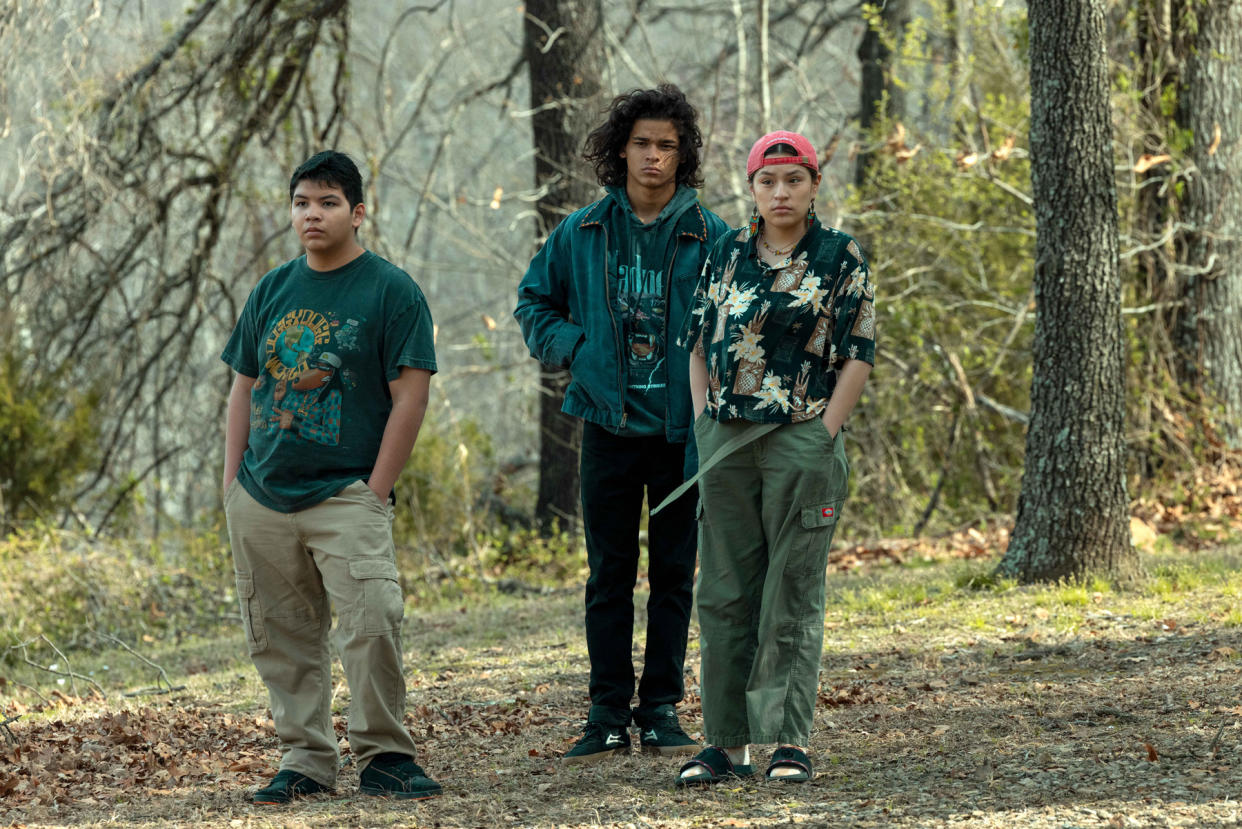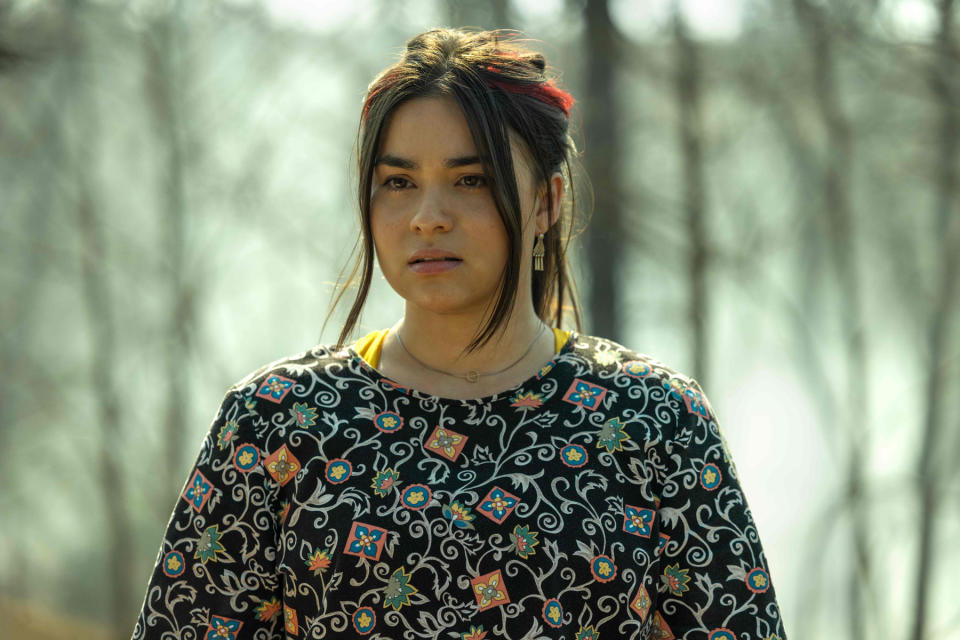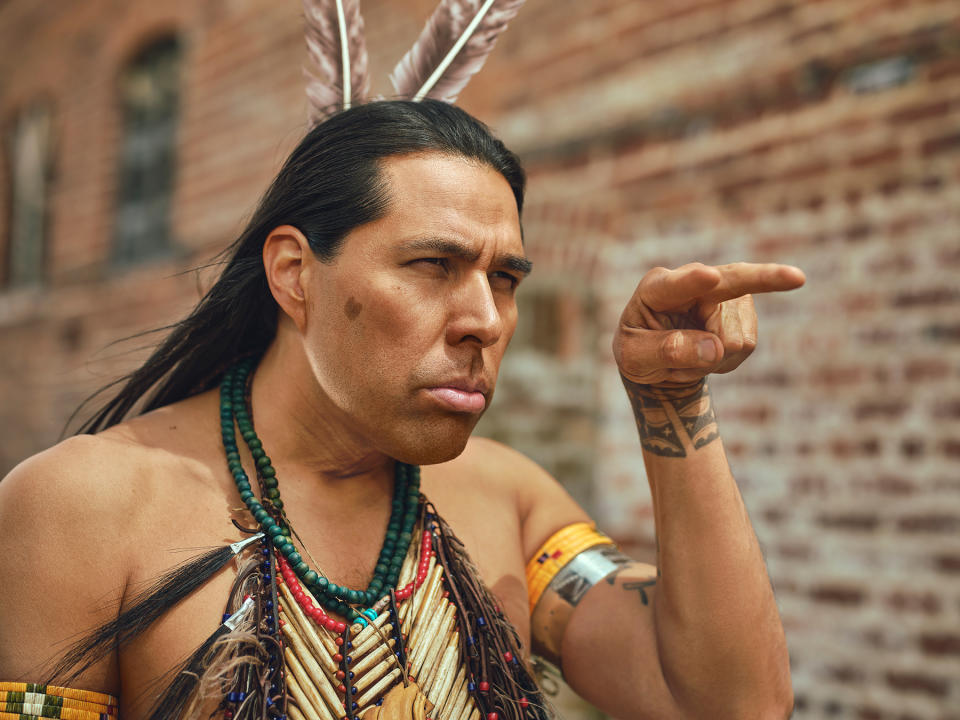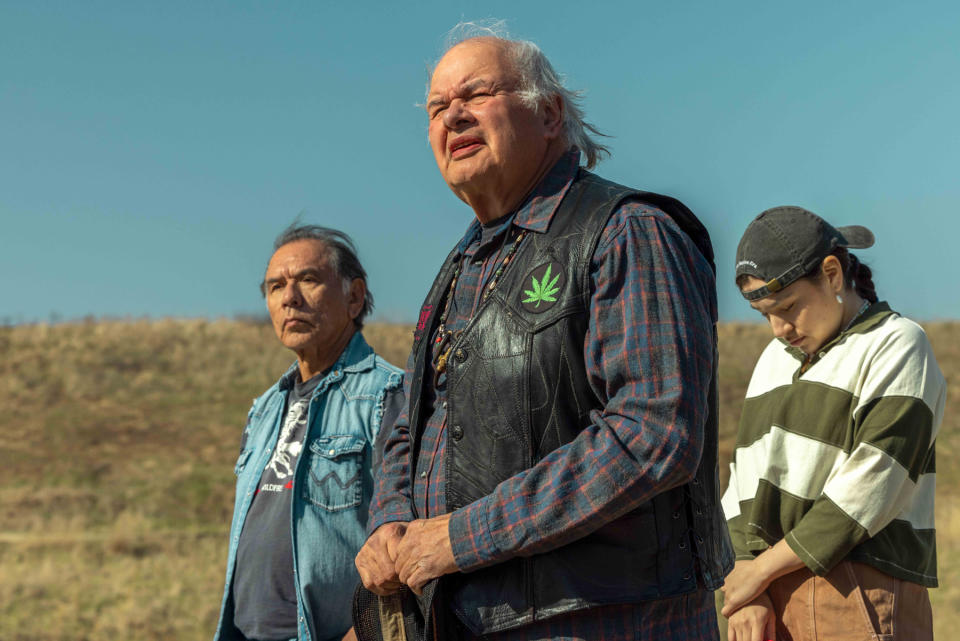‘The Thing Westerns Always Got Wrong Was Our Humor’: Sterlin Harjo on the Return of ‘Reservation Dogs’

- Oops!Something went wrong.Please try again later.
- Oops!Something went wrong.Please try again later.
The fourth episode of the new season of Reservation Dogs would seem extraordinary, if only it weren’t for all the other incredible episodes of Reservation Dogs.
The FX comedy (which streams exclusively on Hulu) follows a quartet of Native teens — would-be group leader Bear (D’Pharaoh Woon-A-Tai), actual group leader Elora Danan (Devery Jacobs), the taciturn Willie Jack (Paulina Alexis), and the agreeable Cheese (Lane Factor) — hanging around their reservation in rural Oklahoma while dreaming of escaping to a more glamorous life in California. The first season of the series, created by Sterlin Harjo and Taika Waititi, was one of the very best TV shows of last year — as distinct in tone and style as it is in its focus on indigenous characters in a medium that has so rarely shown interest in them.
More from Rolling Stone
How to Watch 'The Bear': Where to Stream the Smash Hulu Series Online
'The Bear' Is the Most Stressful Thing on TV Right Now. It's Also Great
'Reservation Dogs' Taps Guests Megan Mullally, Marc Maron for Season Two
The series simultaneously feels small and enormous. The kids’ grand plans never amount to much, yet there is a palpable sense that their worlds are at stake with each tiny decision. Through the ghost of 19th century warrior William Knifeman (played by comedian, and now Reservation Dogs writer, Dallas Goldtooth), the show makes fun of how pop culture depicted Native characters throughout the last century, even as it takes the ideas of spirits, curses, et al. with utmost seriousness. It is a show that feels charming, unforgettable, and like nothing else on television — not even now that there has been the tiniest of upticks of series with indigenous leads like Peacock’s Rutherford Falls and AMC’s Dark Winds (whose star Zahn McClarnon continues his recurring role here as idiotic local cop Big).
The upcoming fourth episode, “Mabel,” involves the reservation coming together to say goodbye to a dying elder in the community. It’s equal parts dry comedy, heartbreaking pathos, and cooking montages, and is utterly lovely. But the episodes leading up to it this season are wonderful in their own right, and prompted a long conversation last week between Rolling Stone and Sterlin Harjo on all the things that go into making Reservation Dogs so special.
You’d never written for scripted television before Reservation Dogs. What did you learn over the course of making that first season?
There was a bit of a balance of, yes, I hadn’t done scripted TV. But I think that that leaned in my favor a little bit. I think it helped create a unique show. It’s the economy of writing for TV that you just get better at. You just realize that you don’t have a lot of time to meander. I can read a script at this point and go, “We don’t need this, we don’t need that.” But also, the style of an FX show is kind of different from other shows. It’s very classic, like how things get set up right from the beginning and then you follow the fallout from that setup. If I was doing a feature, I might take a little more time setting things up. But I love that style of just dropping in on a world and getting moving, right from the top.
It’s funny you say that there’s not a lot of time for meandering, because some of my favorite parts of the show are the meandering bits. You’ll do these episodes where very little seems to happen, yet in this incredibly engaging way. How do you pull that off?
For me, I think it’s because we set this world up. And the world is exactly what I loved about my family’s way of storytelling. I think Native people have this really great way of telling stories, which I’ve always tried to capture. I remember growing up and hearing my family tell the smallest story about going to the grocery store. But it would be so big in the way that they would tell it, it would be so full of characters. Like, they saw this quirky weirdo on the way, and then this this other person that they think is putting bad spells on people. It’s just full of life and mythology. That’s what I wanted to do with this, to tell this seemingly simple story with not a lot happening — but there actually is a lot happening, a lot of characters, a lot of things riding underneath the current.
You cast these four young actors with varying degrees of experience. How did you figure out what they could each do?
A lot of that is just being an independent filmmaker, casting my family for years, casting non-actors for years. I learned how to work with them together and how they pull strengths out of each other. So all of that was training ground for Reservation Dogs. They’re all so different in how they approach things. Sometimes, with Lane, it’s getting him to lock in. A lot of times, his instincts are so right on that you just try not to mess with it too much. Devery comes in and she is so prepared, and is ready to roll, and you can get many different types of takes from her. You can really work with her on what you want to do. Paulina, you just have to kind of stay out of her way and let her feel comfortable to be herself. Every time she adds something, it’s going to be great.
D’Pharaoh is really really internal. We work really hard on these scenes, and he can really get down on himself if something’s not working out. It’s never from a bad performance or anything; it’s just us trying to find this place. But D’Pharaoh takes it very seriously, and doesn’t want to disappoint. With him, it’s about reminding him we’re having fun. It’s amazing what D’Pharoah can do; he can do nothing, and you’re interested in watching it. There’s not a better trait for a leading character than, “I could just watch him sit there.” He’s just got such good reactions, and he knows that character really well. It’s just about giving him the space to be comfortable and do all of that.

Shane Brown/FX.
You brought Devery into the writers room this season. What made you think she should be there as well as in front of the camera?
It was a no-brainer bringing her into the writers room. She is a really talented storyteller and filmmaker herself. There were moments in Season One where she would just politely bring up a concern and a solution, and that’s what you want in a writer. Also, she knows that character Elora Danan so well, and it was this opportunity to have her come in and really expand on that character. When she handed in a draft, I couldn’t have been more happy or proud of her work. She’s such a good writer.
Often when I visit writers rooms, the big challenge will be how to find a new way to tell the kind of story viewers have seen a million times. But there have been barely any shows focusing on Native characters before these last few years. What kind of advantage does that give you?
It’s such an advantage. We have this opportunity to show a world that, right off the bat, no one knows about. That is what most show creators, writers, strive for with their work. “I want to have this be so unique that audiences are leaning in and want to know more, and you have them in the palm of your hand.” Right off the bat, we have that. It’s really hard to screw that up. On top of that, we have good writing.
Cultures are not monolithic, and you’ve got writers from different backgrounds and parts of the country. What happens when you’re working on a story and some of the writers’ experiences with that particular idea are different than others?
We stick to the tribe in which we’re basing the story, which is mine. [Editor’s note: Harjo is a member of the Seminole Nation of Oklahoma, and also has Muskogee heritage.] That’s the guiding light, but whenever there’s commonality, we try to grab the common aspects of all of our cultures. If something’s very specific from somewhere else, but we try to find what’s common to all of our communities, and that’s what people are going to relate to. It translates even to non-Natives when we do that.
Your fourth episode [from Season Two], “Mabel,” is just incredible. What specific aspects of that did you want to be sure to include within that half-hour?
Everyone had that experience of people coming together to see someone off in our communities. It was very specifically based on us doing that for my grandma. In a very similar house, the layout is exactly the same as the house that we shot in. So it’s based on that, but I cowrote it with Devery, and that was also some of her experience. We would pull from everyone’s experience, and we all had that in common with someone passing. We had all had a similar experience, seeing a loved one go.
That episode, like so many that you make, has this really elastic tone, where parts of it are incredibly sad and parts are really funny. How do you maintain that?
I don’t know how to do it any other way. I think there’s something very Native in the tone and style. Our humor has always existed next to tragedy and drama. It was a coping mechanism, our humor. It was a way of survival during hard times. So it’s ingrained in the way that I think about things. I can’t imagine not doing that. I approach an episode like that one and I don’t think, “Oh, this is going to be so sad.” Some of the most funny, fun times we’ve had are funerals, because we’re all getting together. To me, there’s no way I could have made that just one note. It wouldn’t have felt right. It wouldn’t have been worth telling. Whenever I see something like that that’s just dramatic, I find that it feels very false. It feels very real, to be funny and dramatic at the same time.

Ryan RedCorn/FX
The spirit of William Knifeman never fails to make me laugh whenever he turns up, yet the show takes the larger ideas of Native spirituality very seriously. How generally do you want to portray that aspect of the culture?
The one thing that Westerns always got wrong is our humor. There were definitely characters like William Knifeman back in the day, cracking jokes and acting cooler than they are. I think that character reminds people we are human, but also flips the stereotype on its head, and acknowledges that the stereotype is somewhat truthful. For people who are not used to modern Native stories, I think that character makes them comfortable — to be invited into that world and get used to the humor, because that is the image that they’re used to. For better or for worse, the image that they’re used to seeing looks like William Knifeman more than it looks like me. So it invites them in, and once they’re in, shows them the humor and says, “We can laugh at this together.” I think that it’s crucial in having a non-Native audience roll along with the punches and roll along with the humor.
But through his humor, he’s also saying real things. In our third episode this year, he talks about mourning people who have passed. He’s in a Porta-Potty, but he says some really wonderful things in there about how we, as an indigenous people, evolve through the loss of someone. And sometimes the serious things he’s saying come in the form of him saying the opposite of what you should do. So you kind of have to decipher if he’s telling the truth or not.
Am I correct in feeling that characters are saying “shitass” a lot more in this season than they did in the first?
Most definitely. We’ve bumped the shitass factor up by 20 percent in Season Two.
Why?
I think you’ve gotta raise the stakes.
Is there possibly a point where there is too much “shitass”? Do you ever find yourself saying, “All right, they’re saying too much in this scene, and we need to dial it back”?
Oh, we’ve cut out a lot of shitasses. There are conversations where we’ll ask, “Is there too many shitasses here? Let’s take this out.” So there will be episodes without shitasses in this season. Never fret.
The response to that word has seemed very strong to me, people going, “Oh, this is a new curse word. I can use this.”
Zahn, actually, is the one who says it so smoothly. It was an improvisation in Episode 102 last season. And I just had him say it over and over, and then I had other people say it, and then I decided people should be saying it to the kids. Any time you can change culture and bring a word back? I think it’s fantastic. At least we’re doing something right.

Shane Brown/FX
The characters are eating food from Sonic a lot. Why?
It’s just local and I grew up eating there. Every small town has one. At some point, they’re going to need me to direct some of their commercials or something, because I’ve been giving them a lot of free press. Or at least, like, a gift card — an endless gift card to Sonic.
You’re sharing Zahn with Dark Winds, and there are a lot of cast and crew who have done both of those shows, or done your show and Rutherford Falls. Some who’ve been involved with all three. How much are you in communication with the producers on those shows to make sure it all works?
Yeah, we all know each other. And there’s not a giant pool of Native actors. But we’re creating more. There’s going to be more interest, now that there’s actual opportunities. But we all communicate, we all know each other. We all share writers and directors, actors, casting directors, and things like that. So we’re always in communication and trying to see if people who are available. We talk.
And it’s a good thing that there are three different kinds of Native shows on television at once, right?
For sure. And I think there’s going to be more coming out. I think it’s going to blow people away how diverse the stories are going to be. It’s exciting.
The first two episodes of Reservation Dogs Season Two are streaming now on Hulu, with additional episodes releasing weekly.
Best of Rolling Stone

